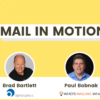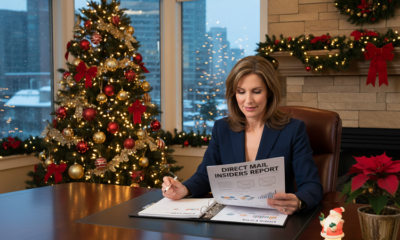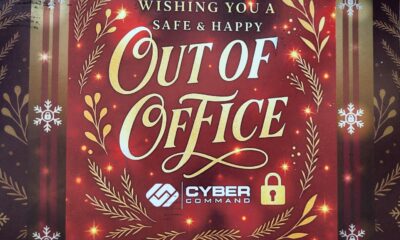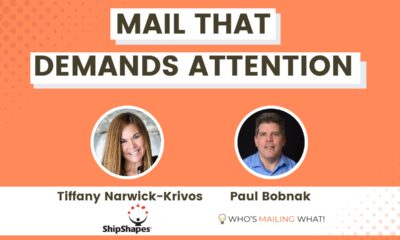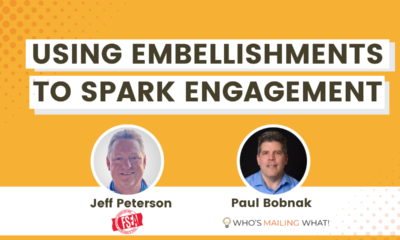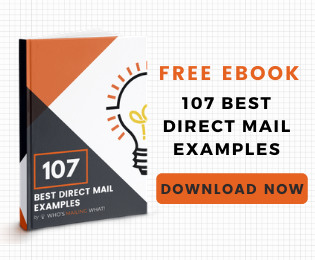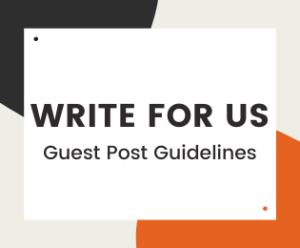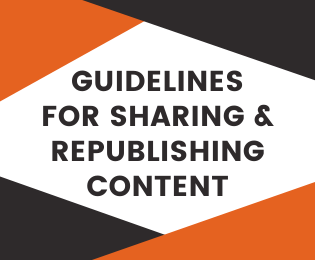MEET THE MAILERS
Meet The Mailers: Cards That Drive Direct Mail
In this episode, we talked with MCT about the company’s production of plastic and paper cards for direct mail campaigns.
In this episode, I talked with Karen Brooker, VP of Growth Strategy for Marketing Card Technology (MCT). Headquartered in Downers Grove, IL, MCT is a single-source provider for card production and direct mail services.
Using examples from different industry verticals, she showed how brands and nonprofits use plastic and paper cards to boost response.
Brooker highlighted the tactile value of a physical card in a mail campaign.
“Almost all card packages get opened, so that’s the very first challenge that a marketer has — to get their message seen.”
 Karen Brooker
Karen Brooker
VP of Growth Strategy,
Marketing Card Technology
Among the many topics we covered:
- Karen’s background in the industry
- MCT’s card printing capabilities
- USPS promotional discounts
- Sustainable options for card production
- Her favorite recent direct mail campaign
Here are some questions and answers from our conversation (edited for clarity and space):
- I’ve seen a lot of cards used over the years in direct mail acquisition. So the question is: Why? Why do they work? Why is it that they’re still a big part of direct mail for a couple of decades here?
I think a big reason for that is – and I don’t think I could have predicted this when I started in the business – even today, cards carry a perceived value in the consumer’s mind. Just yesterday I got my new Prime Chase credit card, and it’s a metal card. They changed it up from the last metal card I got from them, so this one is kind of a classy blue metal card.
For whatever reason, cards resonate with consumers as items of value, and so they spark curiosity. The nice thing is you can feel the card in the direct mail package before you even open it up. Right off the bat, there’s an enticement to open that envelope. Almost all card packages get opened, so that’s the very first challenge that a marketer has is to get their message seen. So I think that’s a big part of it. Once you open the package, the card tends to draw the eyes. So different marketers will use the card for different purposes, and I’ve got a few examples here. We published an ebook – which is available free – which talks about the different ways you can use cards in direct mail.
Some cards, some mailers are using cards to highlight an offer. So here’s an example [shows mailer] and you’ll see one of these two cards doesn’t even have the brand name listed. So there’s no logo. It’s just the offer, it’s the key message. We have other marketers that use what we call a full card.
Here’s another [shows mailer] that’s highlighting an offer, and then you’ve got cards, especially in the nonprofit space, cards that give the consumer a sense of membership, a sense of ownership, a sense of belonging … whether it’s a charity, or whether it’s a club. I think that’s the key, is understanding that there’s so many different things you can do with that card once you open the package.
- What I like about that is, especially with nonprofits, is being intentional about when you use a card. It gives people, like you said, that sense of belonging, the sense of pride …it’s really a lot more to the emotional core of that package and being part of that great cause.
And we do see in the nonprofit space, some nonprofits using the card as a memento, as a keepsake, so they will use artwork for the front of the card that has some emotional value to the consumer that’s receiving it, or maybe on the back of the card. They might have a calendar for the year or a tipping guide or something that makes that consumer want to hang on to that card and keep it close. And it helps with kind of that repeat giving and things like that. I wanted to mention also with both nonprofit and with…I’ve also seen insurance mailers do this where they will solicit new customers with a temporary card, with kind of the promise of a permanent card on the other side of the purchase… or the other side of the gift. And so in that case they might go with a very low cost kind of throw away card for that initial mailing, and then when there’s a response, the consumer receives a hard card which is maybe more elegant. It’s more durable and it’s something that they’re going to hang on to.
- Thinking about strategy, what kinds of things should a mailer consider when planning a campaign that might use a card? Somebody who hasn’t done that before, what kinds of things should they really think about?
Once you’ve kind of identified the purpose of the card and figured out what work it’s going to do in your direct mail piece, from a practical standpoint, you want to make sure you’re using very high resolution artwork. And then keep in mind that the card is a very small canvas, so don’t try to do too much. There’s only so small you can go with a font and have it be legible to your audience, and keep your audience in mind when you’re picking your fonts. I have seen the mistake made frequently of having a very noisy background on the card front and then attempting to personalize that card with a name and number. I feel like when you do personalize a card, it adds a lot of value. But if it’s hard to make out that personalization because the background has all of this commotion, I think you’re missing out on an opportunity. Make sure you think about that space where the personalization is going to live and kind of make room for it. Have good contrasting colors.
- Are there any types of uses that would involve the USPS promotion program?
So the tactile sensory and interactive program is running this year until July 31st, we’re seeing the post office repeat it. There is still time for that for this year and the Postal Service has been really great at recognizing the tactile and interactive value of a card in your mailing. So here’s an example of an embossed card. [shows mailer] I mean, you can feel the raised embossing. I don’t think we’ve had any applications for approval for that program turned down and that’s a 4% discount on postage which is incredible!
- Yeah, considering the concerns about the increases over the last four years.
Definitely take advantage of that one. And we do look forward to doing that again next year.
- And you will work with a marketer who maybe hasn’t used a card in the past, but says that “we have a couple of ideas” or “we’re asking you for ideas” about something that can be used and might be eligible for this promotion discount?
Absolutely! I mean we can. There’s certainly sensory inks you can use, scented inks and things like that, but the simplest way is simply to emboss a card, and affix it in the package. It’s literally as simple as that. So we have clients that run card programs all year long and once the season starts for that promotion, they jump on board. And so we will work with new clients to design … We’ve got a handful of just stock backgrounds we can provide for those clients that are having difficulty with finding the resources for design, and then you get a card added to the package, and you’re pretty much paying for it with postal savings.
- I’ve seen a lot of – speaking of embossing – where the card that’s inside [the envelope], the embossing almost shows through as an impression. So besides the tactile factor, you have the visual impact of it as well or it shows through an additional window on the front of the envelope.
I have seen marketers print in a very light screen the impression of what looks like creases from the embossing on the outside of an envelope. It’s a teaser and it looks pretty real. It looks like those creases were created by the card inside.
- I want to touch on the environmental impact of using cards. Sustainability is important for some clients and their customers, or members, in the case of nonprofits. How are you addressing that with them? If they come to you with that concern, both in terms of education as well as alternatives?
For embossed cards, PVC remains the best-performing material and is not ideal from an environmental standpoint. So we do offer recycled PVC. If you do want to stay with embossing and you want the quality of a PVC card, but lessen your impact, you can go with a recycled PVC. We offer a variety of other materials if you are looking at personalization methods other than embossing. We have our Go Wild Reduced PVC and PVC Free materials. Both of these contain a majority of calcium carbonate, which is chalk, and so they are healthier to produce [and] at the end of [their] life when it comes time to dispose of it.
But we are also producing more and more paper cards. This is a high-end paper with a full faced foil. [shows example] They are beautiful in person and we have free samples available for anybody who’s interested in taking a look. This particular form of foil material does not have a plastic carrier. So the nice thing about that is that when you’re done with the card, you can literally tuck it into your paper recycling and it will recycle curbside with your mixed paper.
So there are a lot of options for sustainable papers and alternative plastics for those marketers that want to move away from PVC.
- Talking about trends: with your experience, your point of view, the kinds of customers that you talked to, what kinds of trends are you seeing for direct mail and especially any new technologies that might be incorporated into cards and used in mail?
If we step outside of direct mail for a moment and think about the other functions of cards, there are some pretty exciting technologies in the payment and access card space. [T]ap to pay, for instance … we’re developing technologies that will allow you to pay with a card that doesn’t have any visual numbering on it…cool, biometric and other technologies that are in payment and access cards help create ideas in the direct mail space. Because they’re getting consumers again excited about cards. Kind of keeping that perception that cards carry value, that they offer security, that they offer financial power and then we take that and we kind of use that. So I think what is key right now is for marketers to do what they do best and to always be testing. Now is not the time to kind of stick with what worked in the past, because with postage rates going up, it’s more important than ever that you are looking for the highest return and the lowest cost for that return.
- So what mail piece – this is a question I ask everybody – what one direct mail piece, that you may have received recently, really made you stop and pay attention and maybe even respond to?
This is going to seem silly because it’s not a very elaborate direct mail piece, but I’m a DSW customer. So for those who don’t know, DSW is a shoe retailer and so I wanted to show you a sample because you told me you were going to ask this question and I couldn’t find it. And I think it’s because I already used the offer.
[I]’s a three-panel self-mailer. Inside there was attached two cards that were separated by a perf. [O]ne of them had an offer that you could redeem right away, which I used immediately. The other one was an offer that would be good, like, three weeks later. DSW has been really good at mailing regularly, but not too much.They always include an offer that justifies a trip to the store, so it’s something. And at least one of the offers in the piece is available right away. So when I get a mailing that only includes offers that I have to wait for, sometimes I forget, right? In this case there’s something that drives me to the store right away. I feel like all it takes is one or two mailings that really connects, that really brings value to create a positive habit for the audience. And now they’re looking forward to the next mailing and when they receive it, they’re going to open it up right away.
So that would be my example of somebody who’s doing very simple mailings. They’re incorporating a card which I love and yeah, they’re doing it well.
Here is our conversation (with all questions and answers). We’ve added timecodes for your convenience.
Thank you very much, Karen, for sharing your perspective and your expertise! To learn more about Marketing Card Technology, visit their website at MCTechnology.com.
Your comments and ideas are very important to us in making your Who’s Mailing What! experience even better for you. Through these engaging talks, we hope you’ll take away practical tips, insights, and personal stories to inspire and build your own success.
If you have any feedback — or are interested in sharing your story and viewpoint with our wide and diverse audience on “Meet the Mailers” — please reach out to me. I’d love to hear from you!








